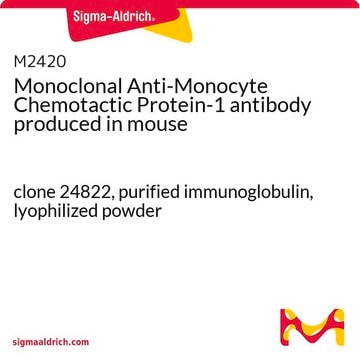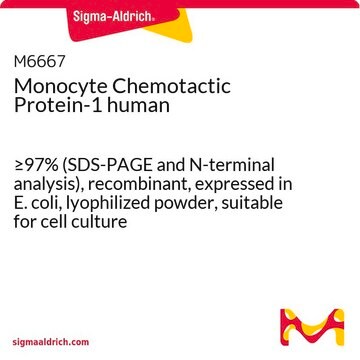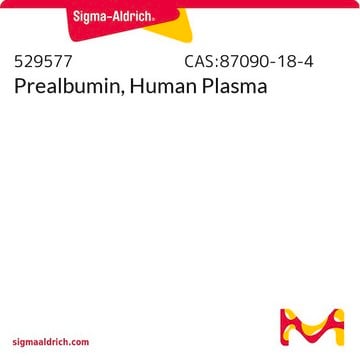R9388
Retinol Binding Protein from human urine
buffered aqueous solution
Synonym(s):
CRBP, Cellular retinol binding protein, RBP, RBP-1, Retinol Binding Protein I
Sign Into View Organizational & Contract Pricing
All Photos(1)
About This Item
Recommended Products
biological source
human urine
Quality Level
Assay
≥85% (SDS-GE)
form
buffered aqueous solution
technique(s)
cell culture | embryo: suitable
transfection: suitable
UniProt accession no.
shipped in
dry ice
storage temp.
−20°C
Gene Information
human ... RBP1(5947)
General description
Retinol Binding Protein (RBP) is a member of lipocalin superfamily. The normal concentration of RBP in serum is 40 to 50 μg/mL and has a molecular weight of 21 kDa. It has a turnover rate of 4 to 24 h. RBP is produced in the liver in response to retinol binding trigger. It is also produced in kidney, sertoli cells of testis. RBP contains a single globular domain and a highly conserved N-terminal region. It has eight antiparallel β sheets in the centre which binds retinol. In human chromosome, the gene encoding RBP is localised at 3q23.
Application
Retinol Binding Protein from human urine has been used:
- as one of the protein in microinjecting mesencephalic cavity of chicken eggs to monitor embryonic cerebrospinal fluid/embryonic serum protein transfer
- as an additive in basal medium for RNA transfection experiments
- in the antibody-derivatized affinity pipettes preparation for the capture of affinity proteins
Biochem/physiol Actions
Inflammation induced by lipopolysaccharide (LPS) exposure caused a reduction in the level of retinol binding protein produced by the liver.
Retinol Binding Protein (RBP) is a specific protein for the transport of vitamin A. The apo-RBP, formed after delivering retinol to the tissues is catabolized by the kidney. The plasma concentration of RBP is less in diabetes mellitus patients. RBP binds to the carrier protein transerythrin, to prevent its loss during glomerular filtration. RBP is implicated in initial neurogenesis and neuroepithelial cell proliferation. RBP is responsible for blepharophimosis syndrome (BPES).
Physical form
Solution in 10 mM sodium phosphate, pH 7.4, 150 mM NaCl, and 0.05% NaN3
Storage Class Code
10 - Combustible liquids
WGK
WGK 2
Flash Point(F)
Not applicable
Flash Point(C)
Not applicable
Personal Protective Equipment
dust mask type N95 (US), Eyeshields, Gloves
Certificates of Analysis (COA)
Search for Certificates of Analysis (COA) by entering the products Lot/Batch Number. Lot and Batch Numbers can be found on a product’s label following the words ‘Lot’ or ‘Batch’.
Already Own This Product?
Find documentation for the products that you have recently purchased in the Document Library.
Assignment of the cellular retinol-binding protein 1 gene (RBP1) and of the coatomer beta' subunit gene (COPB2) to human chromosome band 3q23 by in situ hybridization
De Baere E, et al.
Cytogenetics and Cell Genetics, 82, 226-227 (1998)
F J Rosales et al.
Journal of lipid research, 37(5), 962-971 (1996-05-01)
The acute inflammatory response to tissue injury and infection is associated with low concentrations of plasma retinol and its specific transport proteins, retinol-binding protein (RBP) and transthyretin (TTR). To examine the kinetics and mechanism of hyporetinemia, we have induced acute
Vitamin A in Health and Disease, 87-95 (1994)
Laboratory Tests for the Assessment of Nutritional Status, Second Edition (1999)
Plasma retinol binding protein: structure and function of the prototypic lipocalin
Newcomer ME and Ong DE
Biochimica et Biophysica Acta, Protein Structure and Molecular Enzymology, 1482(1-2), 57-64 (2000)
Our team of scientists has experience in all areas of research including Life Science, Material Science, Chemical Synthesis, Chromatography, Analytical and many others.
Contact Technical Service







